How to cook pork shoulder steak on the stove.
Go straight to the Recipe Card or
Read on for relevant tips and step-by-step pictures (2 mins)
About This Pork Steak Recipe
The ease and convenience of a skillet cooked pork steak culminate in tender, juicy meat. The flavors born from the sizzling fat with which shoulder blade steaks are marbled are some of the best pork has to offer. We (enthusiastically) prepare the cut several times a month and are never disappointed.
For this really simple recipe you will employ a seasoning rub for the pork which penetrates the steak surface and flavors it. If you would rather use a marinade consider these two favorites of ours – Marinated Baked Pork Steaks or Marinated Grilled Pork Shoulder Steaks.
For more inspiration you can review the recipes in this compilation of Pork Marinades.
You Will Need Pork Shoulder Steak and…
What is the difference between pork steaks and pork chops? A pork steak is typically cut from the shoulder blade area of the animal and often includes a cross-section of the blade bone. It is juicy and very flavorful. A pork chop is typically cut from the loin, which runs from the shoulder to the pig’s hip. The exact cuts vary (sirloin chops, loin chops, rib chops) but in general they are all a bit dryer. That being said, there are also pork steaks cut from underneath the picnic shoulder, known as arm steaks and pork chops can be carved from the neck near the shoulder – these collar chops are possibly the most flavorful pork chops you will ever taste.
- Pork shoulder (blade) steak. An inch is the ideal thickness for pan-frying a pork steak. You may find it containing shoulder blade bone or boneless, depending on what part of the Boston butt it was carved from.
- Pork seasoning rub. Use your favorite mix, store-bought seasoning for pork chops or mix the one listed in the recipe card.
- Olive oil & parsley. You can also use vegetable oil. Parsley is a classic garnish for pork steaks and chops, but thyme, green onions or oregano will work well too.
- Cast iron skillet. Cast iron or another heavy bottomed skillet that is at least 10 inches in diameter. When the pork steaks are larger, over a pound each, we often parallel cook them on adjacent burners to speed up the process.
TIP: Here is how to cut your own pork steak from a whole pork shoulder blade roast. Alternatively, you can ask the people at meat department of your store to slice a steak ready whole pork shoulder with the band saw – usually they are happy to do that.
How to Cook Shoulder Steak in a Pan
You can, if you want to, especially if the pork steaks are much thicker than an inch. We rarely do however – for one using a meat mallet can force detach portions of the steak meat from the shoulder blade bone. Additionally, this cut of pork naturally becomes tender when cooked over moderate heat, it does not dry out in the manner of leaner pork chops.
- Prep. Pat dry the pork steak. Mix the seasoning rub and be liberal in using it. Rub into the meat and let the steaks sit for at least 30 minutes (refrigerate if longer). Alternatively, marinate the pork steaks.
- Pan fry. Heat skillet over medium-high for about 2-3 minutes. Add olive oil and sear the pork steak(s) for about 2 mins on each side until nicely browned (the Maillard reaction is at work here, creating layers of flavors). Lower the heat to medium and continue to cook. If your steaks just fit in the pan, cook one a time or use two skillets on two burners.
- Rest & garnish. Once the meat has reached your desired doneness, transfer to a warm platter or plate and cover with foil. Rest if for at least 5 minutes for best results. Garnish with parsley or the fresh herb of your choice.
Pan-Fried Pork Steak Temperature
How long to cook pork steak? The short answer is – until tender.
As a rule of thumb, pork shoulder in general and pork steak in particular is a cut you cook until tender.
Therefore the conventional temperature guidelines are irrelevant. Typically, pork is cooked to 145 F (food safe, medium-rare going on medium) and 155 F for well done and the main concern is not drying it out. Not so with pork steak. Besides its far superior flavor, it also has the advantage of remaining juicy as its fat content renders and moistens the meat.
At around 165 F transfer it to a warm plate and let it rest (it will continue cooking). The difference between a pork steak cooked to 145 F (still has a lot of the connective tissue not melted) and one cooked to almost 170 F is significant – try it for yourself.
Sauce Ideas for Pork Steak
Pan-fried shoulder blade steak is already delicious on its own, but if you are in the mood to drizzle a pan sauce over it, here are a few ideas you can easily prepare in just a few minutes while the meat is resting. Hint: use the same skillet in which you cooked the steak.
- Mustard Cream Sauce – use this recipe.
- Honey Dijon Cream Sauce – use this recipe.
- Honey Garlic Pan Sauce – to a skillet over medium heat add 3 tbsp honey, 2 tbsp apple cider vinegar, 3 cloves minced garlic + 1 tbsp soy sauce. Stir, bring to simmer and reduce a little bit.
You Might Like
Braised Pork Steak with Onions
Smoked Pork Steak
Pork Shoulder Roast (with Crackling)
Pork Skewers (with pork shoulder meat)
Marinated Pork Chops in Oven
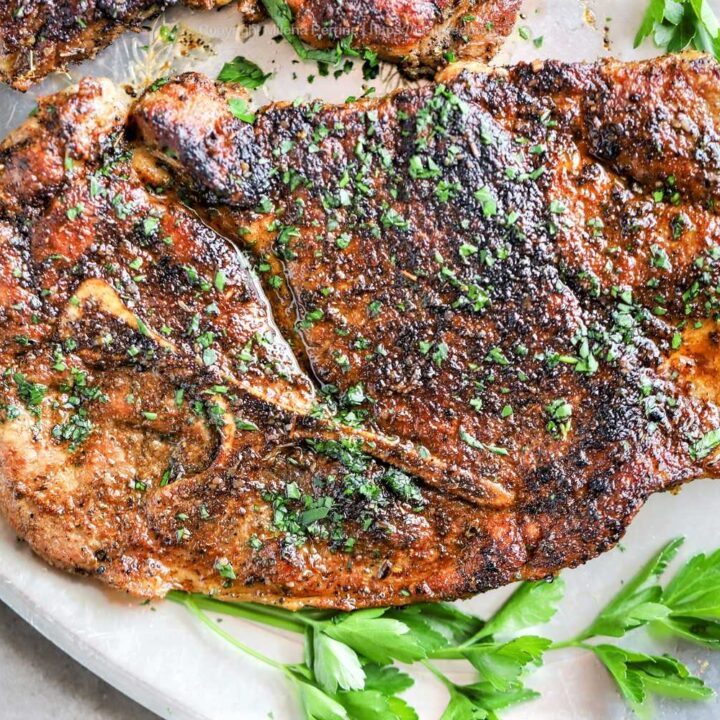
Easy Skillet Pork Steak Recipe (Seasoning Rub + Cast Iron)
How to cook pork shoulder steak on the stove. Make a simple pork seasoning rub, apply it generously then pan sear the steaks to tender perfection in cast iron skillet (or similar heavy bottomed frying pan).
Ingredients
PORK STEAK
- 2 lbs pork steak, about 1 inch thick*
- 2 tbsp olive oil
PORK SEASONING RUB
- 1 tsp coarse salt**
- 1/2 tsp pepper
- 1 tsp cumin
- 1 tsp paprika
- 1 tsp garlic powder
- 1 tsp oregano
Instructions
- Trim any excess fat from the periphery of the pork steak, pat dry. Mix the seasoning rub and season pork on both sides. Gently rub the seasoning into the meat and let it rest for at least 30 minutes.***
- Heat a skillet for 2-3 minutes over medium-high. Add the olive oil and sear the pork steak for 1-2 minutes on each side until nicely browned. Also sear the edges to get them nice and crispy. For large steaks work one steak at a time or use two skillets on adjacent burners.
- Immediately lower the heat to medium and continue cooking until a meat thermometer registers about 165 F when inserted in the center. Transfer the pork steak to a warm plate and tent with foil to keep warm while resting.
- After a 5 minute rest garnish with chopped parsley or other fresh herb and enjoy.
Notes
*you may have 2 or 3 steaks for that weight, depending on how they were cut and how thick
**you may increase to 2 tsp (to taste), especially if using Diamond brand salt which is lighter
***if you just pulled the steaks from the fridge let them come to room temperature with the seasoning rubbed in.
NOTE: While most pork chops are typically cooked until food safe at 145 F, with pork steak you have the luxury of pan-frying it until 165-170 F. The shoulder meat is marbled with fat which melts while cooked over medium heat and moistens the meat. With pork steak it is generally more important to cook it until tender than observing a specific temperature.
For quick, easy pan sauces you can prepare in the same skillet where you cooked the pork steaks while they are resting, consult the post for this recipe.
Nutrition Information:
Yield: 4 Serving Size: 1Amount Per Serving: Calories: 655Total Fat: 45gSaturated Fat: 14gTrans Fat: 0gUnsaturated Fat: 26gCholesterol: 215mgSodium: 740mgCarbohydrates: 2gFiber: 1gSugar: 0gProtein: 58g

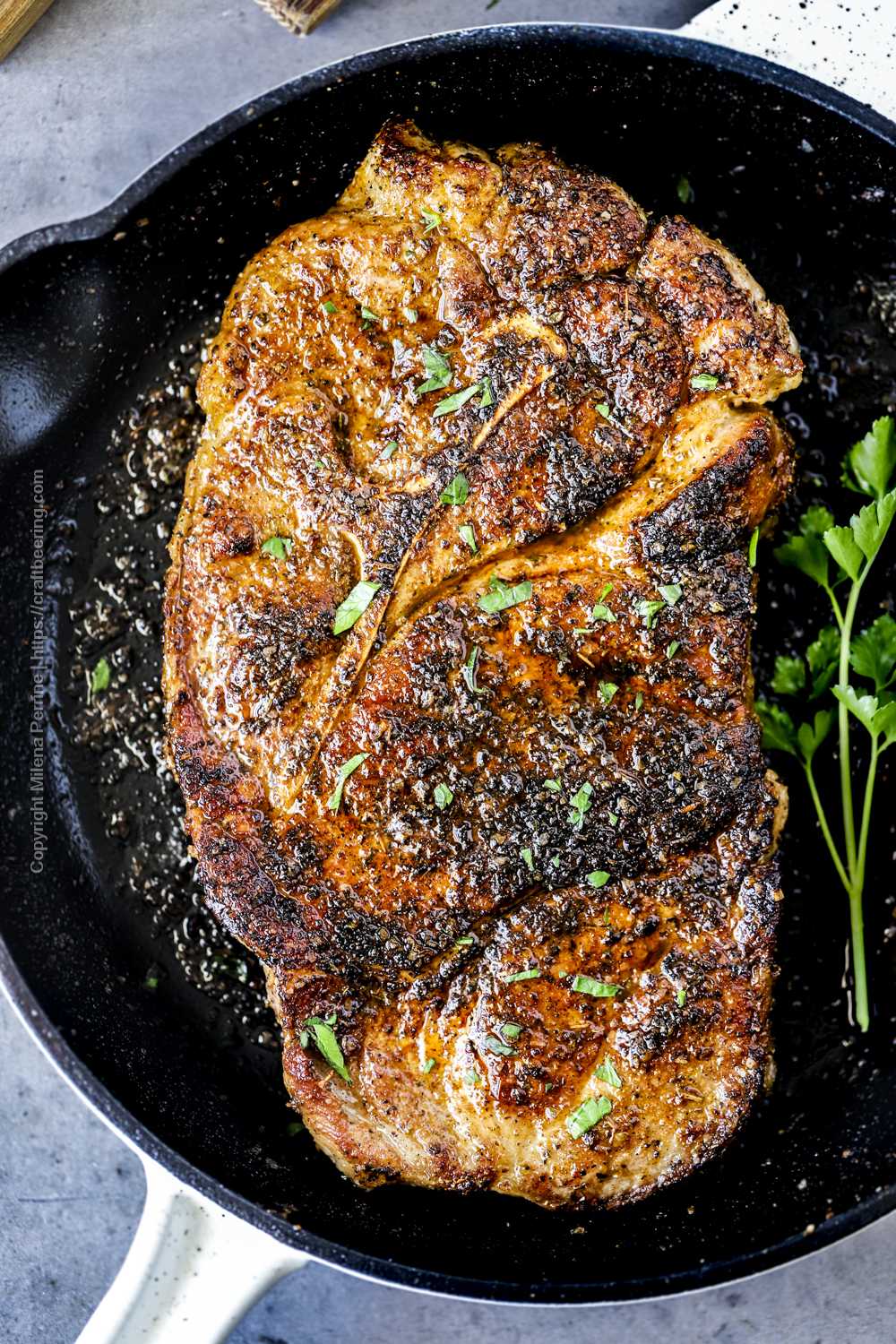
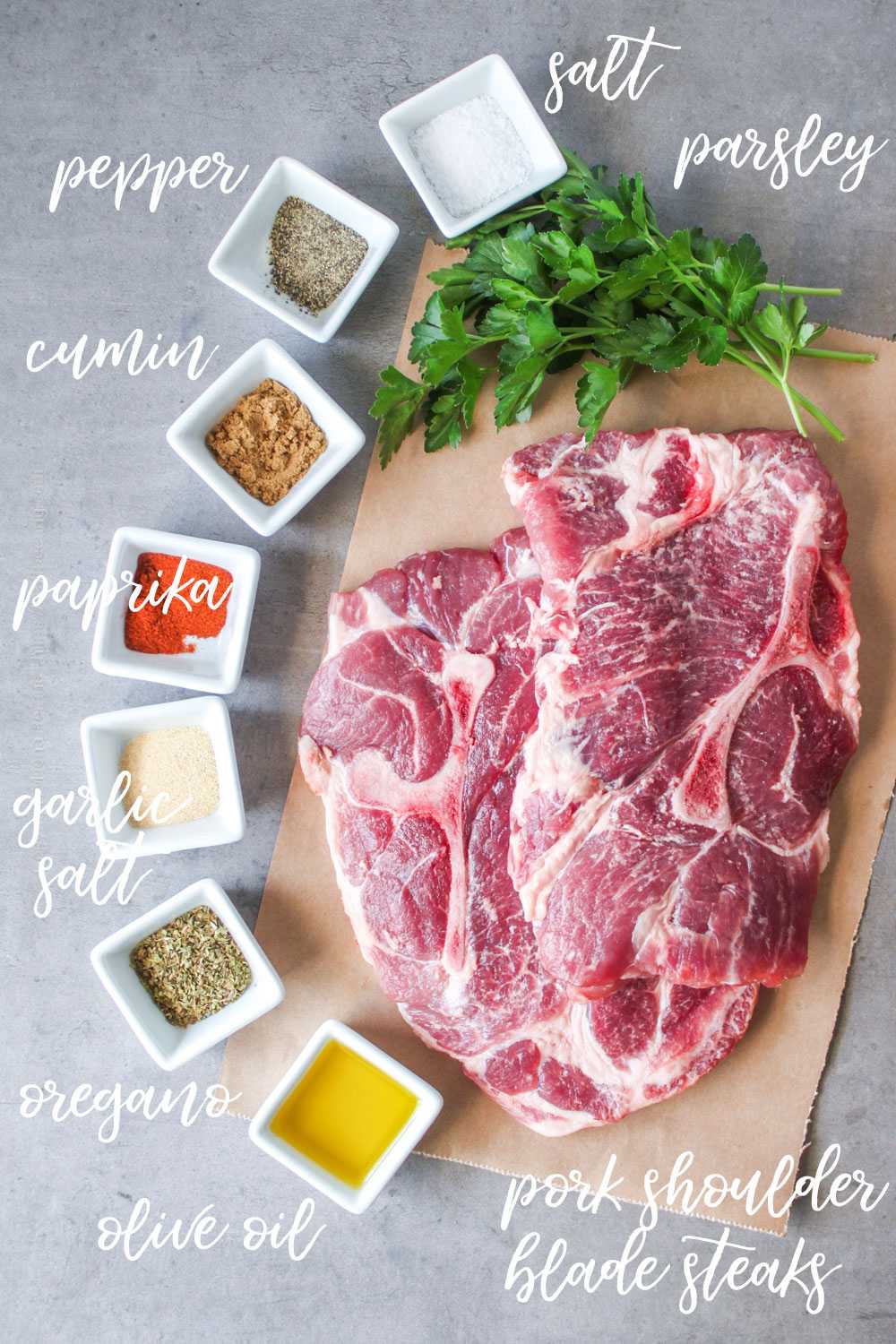
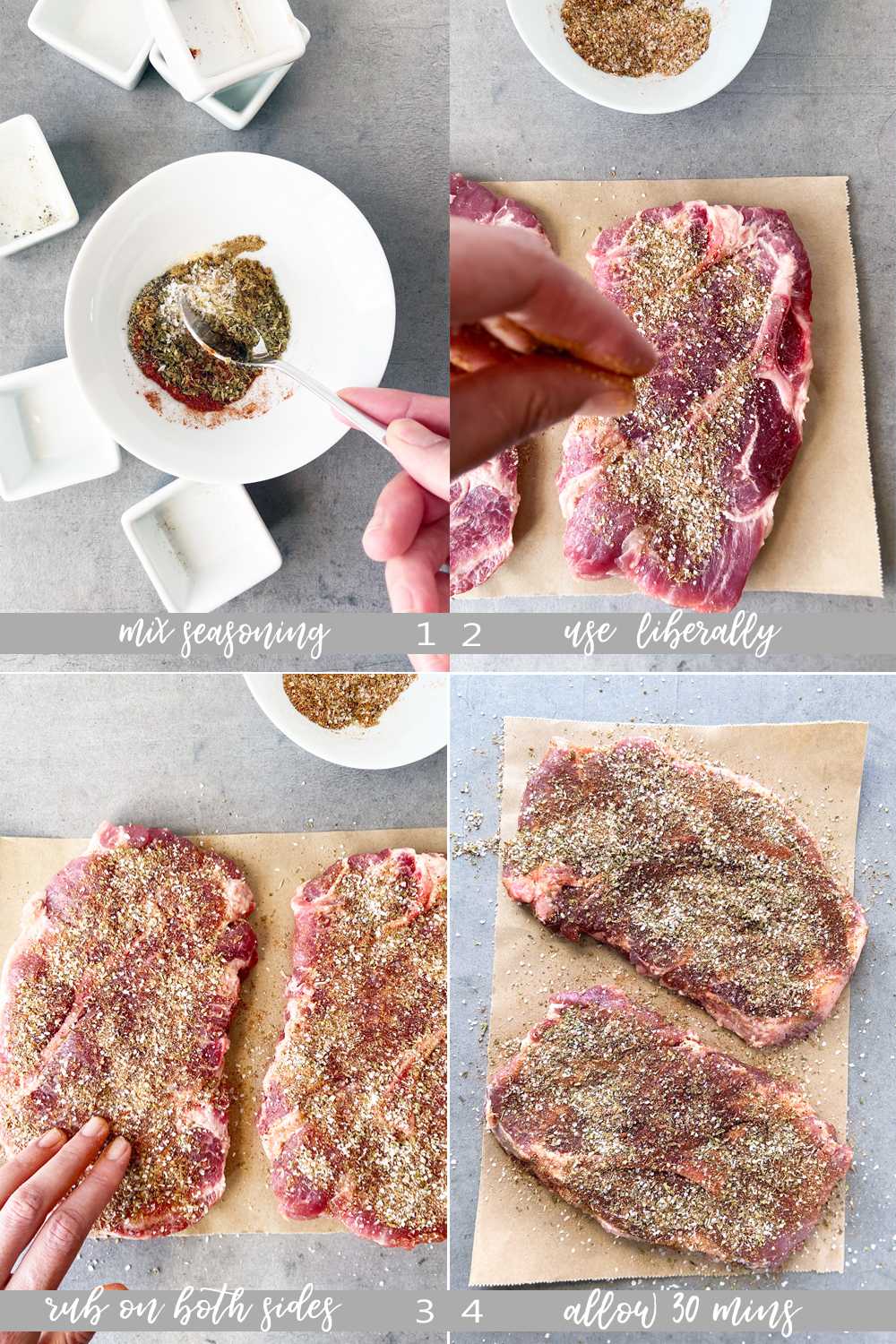
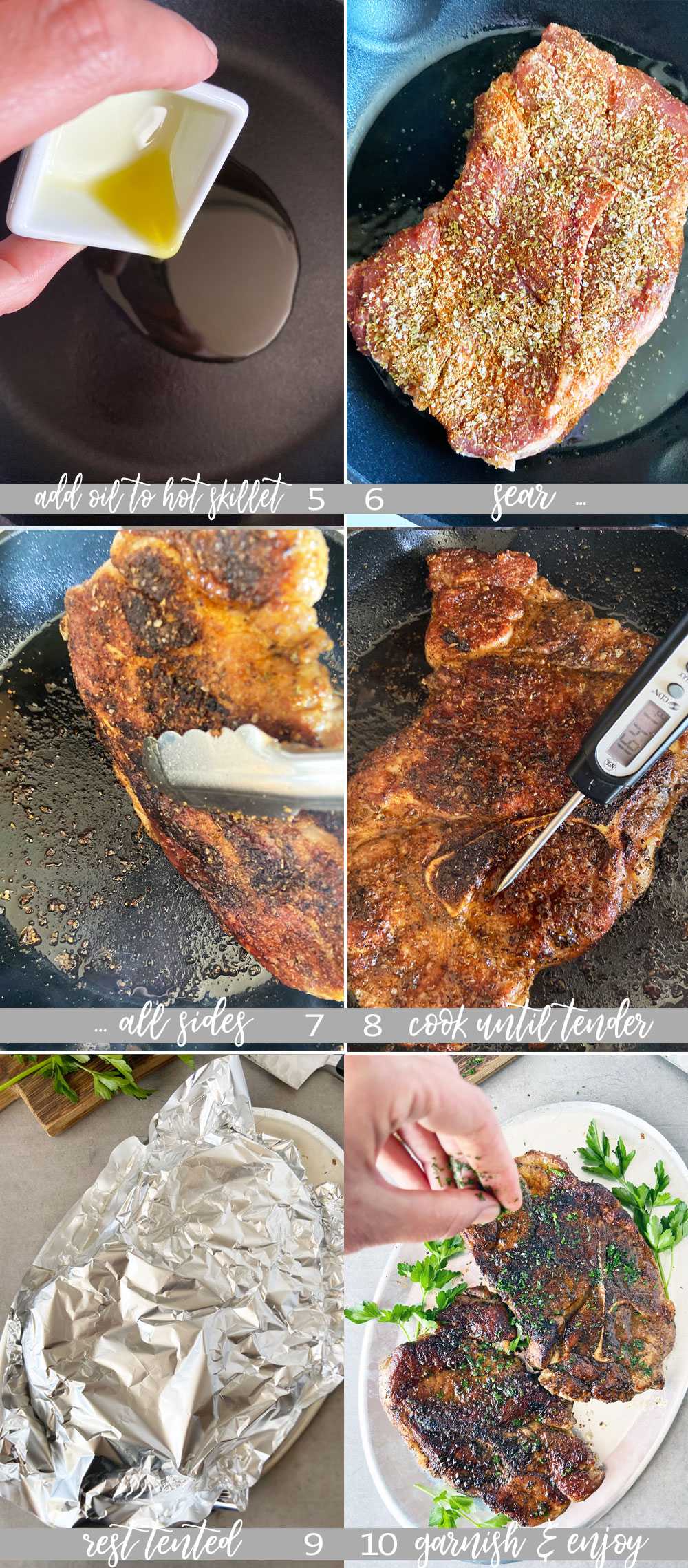
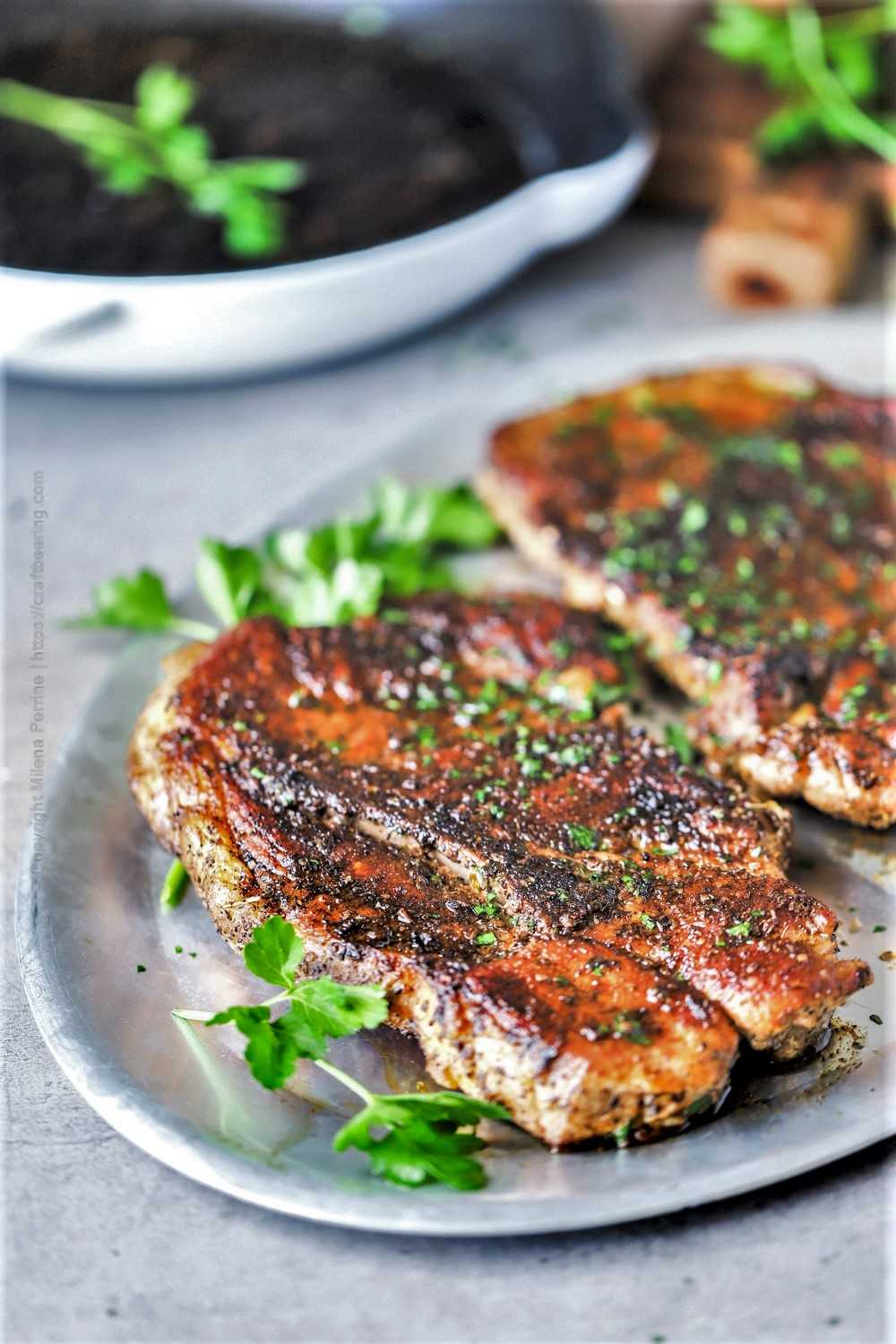
A says
Was a bit suspicious of this spice combination, but boy was it good! Was my first time making this, and I would definitely use this recipe again.
Angie says
Easy and delicious. I used Montreal seasoning for the pork steaks.
James Kelly says
I’m a Texan and this was my first time cooking pork steaks in a pan instead of a grill. I’m also not accustomed to using parsley, cumin, and oregano type spices. Problem is I was out of charcoal and didn’t feel like going to the store. So I thought “What the hell, I might as well give this a try. If I don’t like it I won’t do it again.”. Needless to say I will be using this recipe everytime I can’t grill a pork steak. Grilling is still superior in my opinion, but this was very good.
Milena Perrine says
Definitely agree with you, James! Charcoal or better yet, wood, is the best possible outcome for a pork steak:) Try it with this seasoning, ….mmmmm. Cumin and pork are always lovely together:)
Anna says
Exceptional, easy recipe! I really enjoyed the combination of the rendered sizzling fat and the spice rub. Skillet cooking was so convenient for pork steak and it turned out delicious.
Linda Kellogg says
Have been using this rub since middle of last year and it has never disappointed me. The smell of the rub while mixing is what heaven’s kitchen smells like. Okay maybe not that good but it is a wonderful smell
Jennifer @ Seasons and Suppers says
That is a beautiful skillet! If I showed all your posts to my husband, he’d move in with you 😉
CraftBeering says
Too funny:) Thank you, Jennifer!